
Certificates, often ornate, suitably framed, were a common feature amongst the friendly society Orders, as well as other working men and women’s associations. The antecedent of the Ancient Order of Foresters, the Royal Order, had membership certificates in the 1820’s. Survival of a friendly society membership certificate bearing a name may now, sadly, be the only tangible evidence of a person’s existence. For that reason each one is priceless, and we have over 100!
Dispensations were large documents authorising the existence of a Court of the AOF. Often framed and hung in a Court’s meeting place they represented the formal link of local Court with the Order.What’s special about OUR collection of AOF certificates and Dispensations?
| > | Original research, carried out in our Archive, provides ‘added value’ information about our certificates and Dispensations;
|
| > | Our certificates have the potential to be classified to produce definitive chronological and typological collections for researchers. |
Subject Headings Banners |
Further Reading The Ancient Order of Foresters Friendly Society - 150 Years, Walter Cooper (1984) |
 |
 |
 |
 |
 |
 |
 |
 |
 |
 |
|||||||||
 |
 |
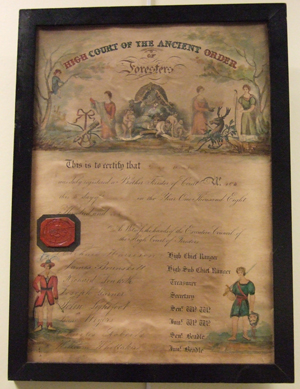 |
AOF Membership Certificate 1834/44 At the Rochdale, Lancashire, convened Meeting of 1834, delegates resolved ‘that a Certificate Plate be provided instead of the card as heretofore used; to be as elegantly designed and engraved as the price to be paid for each copy will allow; to be filled up by a competent penman, in order that the same may be framed to hang up in the residences of the Brethren of the Order. Such engraved certificate to be furnished to Brethren at sixpence [2.5p] each.’ At this stage the description was ‘Register Certificate’, indicating that its issue was linked to central EC registration of all members. A marvellous intention, one which successive EC’s endeavoured to implement throughout the 1840’s and 50’s. As shown in the accompanying image, the basic design, by Thomas Fothergill of Manchester, was simple, whilst added decoration could be elaborate. An explanation for the content is given by Walter Cooper (see further reading) although his source for this is unknown. The few printed words enabled the penman to insert the name, Court number and registration date. Appended below these were the signatures of all 8 EC members. Over 18,000 certificates were printed in the first year, of which busy EC members filled up 16,510. |
|
| Back to Top | ||
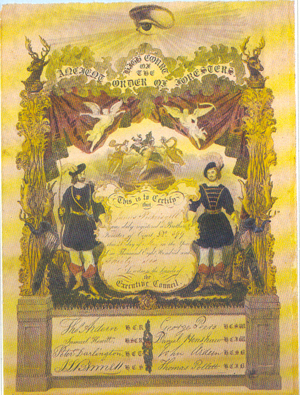 |
AOF Membership Certificate 1844/57 Ten years on from the introduction of the first Certificate, delegates to the London HCM of August 1844 resolved ‘that the Eleventh Executive Council be empowered to procure a new Certificate Plate of membership, and to offer £2 for the best, and £1 for the second, designs.’ The prize was awarded to Mr [H S] Ball, engraver of London. He subsequently undertook the engraving of the plate, at £30, and the initial printing of 13,100 Certificates for £112 5s 1d (£112.25), For colouring 100 of these, he received £2 and producing 100 India proofs, £3. By 1847 the plate was ready for repair, as it was with increasing regularity over the next few years. Illustrated is a Certificate issued, if we go by the names of the EC members whose names appear at the bottom, of 1852. This was the 18th EC based in Knutsford, Cheshire. The certificate belonged to James Pickersgill, a member of Court “Star in the East” No. 399, which met in Wakefield, Yorkshire. The certificate indicates that Bro. Pickersgill was admitted to the Order in May 1836, so this may well be a replacement certificate for an older version.
|
|
| Back to Top | ||
 |
AOF Membership Certificate 1857/97 - A At the 1856 HCM, the Investigation Committee concluded that ‘the Certificate Plate at present in use is completely worn out, and as we think it would be useless to patch it up, we recommend a New one to be obtained, and that a premium of £20 be for the first, and £5 for the second, prize.’ Bro. Aaron Green of Newcastle-under-Lyme, Staffordshire, submitted the winning design, and with engraving by George Greatbach of London, a new Certificate became available in June 1857. Aaron Green, represented Court “Paradise”, No. 1028, at the Bristol HCM in August 1857. Here, with other delegates, he heard a suggestion of that year’s Investigation Committee that the names of EC members, which needed to be changed every year, be omitted and the space created used for Court Officers’ names. As revised, the certificate went on sale, with, as illustrated, an early recipient being Bro. John Lawton, a member of Court “Edgmond”. No. 2447, at Edgmond, Shropshire. Bearing the names of the Court Officers, Bros. Robert Whitfield, Thomas Mansell, and Thomas Roberts, an admission date of 5th September 1857 is recorded. |
|
| Back to Top | ||
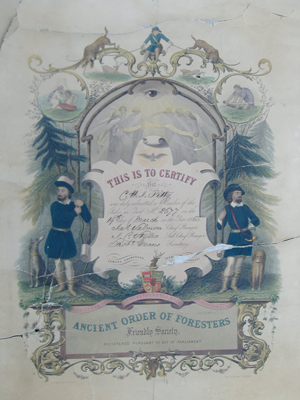 |
AOF Membership Certificate 1857/97 - B Not the best preserved specimen of its type, the Certificate illustrated nevertheless is interesting for several reasons. Firstly, the member admitted, Bro C H Pitty of Court “Royal Saxon”, No 2677, Paddington, London, also joined the Widow & Orphans Fund on the same day, 19th March 1866. His Certificate for the latter is shown below, and together the two form a rare pair. Secondly, the Certificate is linen backed, something not often come across. Thirdly, it is hand coloured. Maria Shawcross, the wife of the Foresters’ Permanent Secretary had started to undertake such work in 1851 for 4d (2p) a copy; here we have an interesting example of how carefully detailed her work was. It is also interesting for showing a few modifications to the previous, similar certificate. In particular, the rather heavy, ornate Officer titles have been replaced by lettering more in keeping with the main text of the document. Other subtle changes have been incorporated, such as in the main heading, and the wording at the base. Few changes appear to have been made subsequently. |
|
| Back to Top | ||
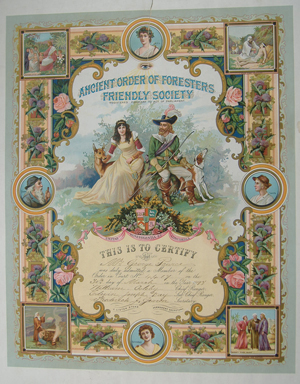 |
AOF Membership Certificate 1897 In January 1897, on a remit originating from the Brighton HCM of 1895, the Norwich EC announced the selection of a design for a new members certificate by Messrs J M Kronheim, of London. In September 1897 the Chester EC advised that ‘the new certificates for members are now on sale. The design is most artistic and should find a wide and hearty acceptance.’ Such optimism was dashed with the expressed dissatisfaction by a minority of the introduction of religious subjects into the certificate. Stocks were withdrawn and a non-sectarian version drawn up (shown below). Before withdrawal of the certificate design a number were issued. Illustrated is the certificate awarded to a member, George Pearce who joined Court “Hyde”, No. 4417 on 30th March 1897. Their meeting place was at Ingatestone in Essex. Its dating serves as a warning about interpreting apparently self-evident information. Clearly he could not actually have received it until the summer of 1897 at the earliest, when it first went on sale. |
|
| Back to Top | ||
 |
AOF Membership Certificate 1899 Stocks of the offending 1897 certificate were withdrawn, at a loss to the Order of some £1800, and a non-sectarian version drawn up. This became available in July 1899, and to un-discerning eye, changes were barely noticeable. The alterations affected the pictorial scenes in each of the four corners. Biblical scenes, with renditions of ‘Suffer little children’, ‘the Good Samaritan’, ‘Abraham’s sacrifice’, and ‘Forgiveness’, were replaced with the more prosaic four seasons. The production of the 1897 and 1899 certificate embraced the decision in August 1892 by delegates at the Ipswich HCM to admit ladies as benefit members. In tune with the era of the ‘new woman’, the move was still problematical for friendly societies since, lacking any other actuarial information of female sickness experience, there was no sound basis for creating viable tables of contributions and benefits for female members. The recipient of the certificate illustrated was George Adams, who became a member of Court “Albion”, No. 4423 at Tring, in Hertfordshire on 14th July 1903.
|
|
| Back to Top | ||
 |
AOF PCR Certificate The first PCR certificate was introduced in 1844. Unsolicited, this was the product of ‘an enterprising Forester of London’, a Brother Hornblower, who offered the design to the London EC. This arrangement continued until 1852. Supply problems arising, the EC decided to have a new Certificate design engraved on a plate to belong to them. George Falkener, of Manchester was the designer and supplier, but his work did not find favour with the Investigation Committee at the 1853 HCM. They concluded that it was ‘a bad thing, badly executed.’ A premium of £5 was offered for a new design, with the successful design coming from J Brelsford. Examples of these two styles are scarce, and if you have one dated earlier than 1857 we would be delighted to hear from you. As with the membership plate the annual re-engraving of the EC’s names was costly to repair and in 1857, alteration to the plate was agreed. In June 1859 stocks of the amended Certificate with Court Officers’ names were available. The style was one which lasted for the remainder of the century. The example shown here was presented to Bro. Willett Keeping of Court “Queen Victoria”, No. 3575, based in Brixton, south London. Undated, the only way to establish when it was awarded is first to see who was Permanent Secretary, in this case Samuel Shawcross, then who was Court Secretary, here Bro. R M Buckett. Detective work in the Trust’s Archive enables a date of between 1871 and 1887 to be given. |
|
| Back to Top | ||
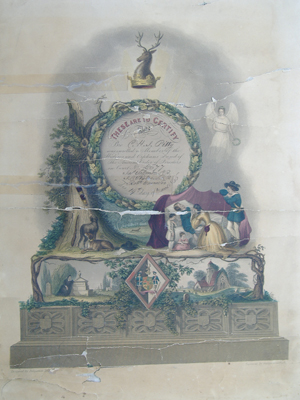 |
AOF Widow and Orphans' Certificate Attempts in the 1840’s to establish a centrally administered fund found little favour with delegates to High Court Meetings. Districts, on the other hand, were more inclined to develop voluntary, locally administered, Widows and Orphans funds and so they became an added value feature of many, but not all, AOF Districts. The principle of looking after members wives and children after their death was a commendable one, in keeping with the culture of caring. The Certificate design was that introduced by the London United District in 1849. Benjamin Foster, an active London Forester, who attained the position of High Chief Ranger in 1860/61, was the designer. The W & O certificate was introduced into the EC saleable stock in 1852, at 8d (3p) plain, 1s (5p) hand coloured. Stocks were acquired directly from the LUD. As with Bro Pitty’s membership certificate, (above) this is not a best quality example, but has the merit of telling us about the desire of this new member of Court “Royal Saxon”, No 2677, to be fully committed to all aspects of Forestry. |
|
| Back to Top | ||
 |
AOF Court Dispensation A fundamental premise of the way in which the friendly society Orders were structured was that a local branch, in the case of the Foresters, a Court, could only exist by virtue of authority being given by the national body, the Executive Council. This authority, called, in the Foresters’, a Dispensation, had to be applied for by those intending to create a new Court in a particular locality. About 2ft 6ins x 1ft 10ins (76 cms x 55 cms), when framed and hung in the Court meeting room, a Dispensation provided a visual link with the Order in its widest sense. Reciting the address of the meeting place, with the names of the three founder members, each Dispensation is a unique object. Their survival, given the often transitory nature of a Court, as members moved from one meeting place to another, is miraculous. Seen here is the Dispensation for Court “Red Rover”, No. 414, dated 23rd March 1836. The ‘well-beloved brethren’ named as founders were Robert Houseman, Stephen Hook and Edward Scott. Initial meeting place was the Bay Horse Inn, Tadcaster, Yorkshire. The Dispensation bears the names and the seals of the 2nd Executive Council, 1835/6, based at Leeds. |
|
| Back to Top | ||
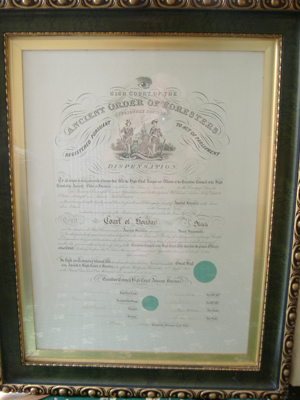 |
AOF Court Dispensation - Female Following the decision of the delegates at the 1892 Ipswich High Court Meeting, female only courts were authorised to be formed in the UK. It was an idea too late for its time and by 1911 female membership of the Order in Great Britain was just one percent, some 8,000 female members (including those in mixed courts) out of 610,000. A fresh impetus came with the introduction of the state National Insurance scheme, some female Courts being established to handle the new arrangement. One such was Court “Court of Honour”, No. 9444, established at the Towns Room, Elland, in the West Riding of Yorkshire. Seen here is the Dispensation granted to ‘Sisters Lily Dyson, Olive Akroyd and Laura Hutchinson’ dated 21st June 1912, by the Leicester EC. At the end of 1912 there were just 8 voluntary members, but an amazing 306 state insurance members. Miss L Hutchinson was the Secretary initially, followed by Miss P G Hunt. The Elland and Ripponden District, to which Court “Court of Honour” belonged, formed a new District Court in 1919 for all state insurance members, and, by 1922, the District had ceased to exist, leaving only Court “Elland and Ripponden”, No. 9826 to conduct state business with 1025 members.
|
|
| Back to Top | ||
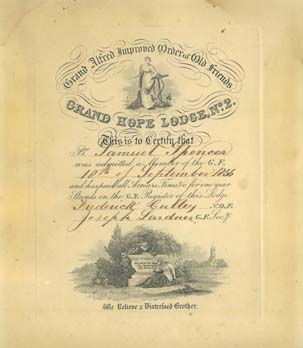 |
Whilst the origins of the Trust make it inevitable that the greater part of its collection relates to the Ancient Order of Foresters, it is within our terms of reference to actively engage with the history of the friendly society movement on a wider level. We were therefore, delighted to receive as an addition to the collection a membership certificate (see image) emanating from the Grand Alfred Improved Order of Old Friends. Our thanks go to the Friendly Societies Research Group, (Dan Weinbren), and Manx National Heritage for arranging the transfer of this item to the Trust’s care. The Certificate is smaller than those of many other Orders, but is none the less attractive for that. The document is in excellent condition, glazed and framed in a wooden frame of high quality. Details on it are clear, showing that Samuel Spencer was the member who received it, and Frederick Culley and Joseph Lardner were the Officers of the Lodge that he had joined. The name of the Lodge was Grand Hope with the Number 2, suggesting perhaps that this was not a large Order. It is dated 10th September 1856. A somewhat obscure Order, any details of its activities and lodge locations would be welcomed. |
|
| Back to Top | ||
 |
Grand Lodge of Scotland of Husbandmen Gardeners The accompanying Certificate is one of two donated a while ago to the Trust by a kind supporter in the USA. Both Certificates refer to the same man, James Laird. The AOF member's certificate (not shown) indicates that he joined the AOF in Court "Royal Burgh", No. 6162, at Rutherglen, in Lanarkshire , in 1884. The certificate illustrated is of the Grand Lodge of Scotland of Husbandmen Gardeners. The pictorial symbolism would bring joy to the heart of any Da Vinci code adherent, as would text with its incisive wording "Light Ariseth in the East and setteth in the West." James Laird was accepted as a member of the Grand Lodge in September 1902, or, as it was alternatively enumerated, the year of Light 5906. Recorded on the certificate is the bearer being made a member of the lodge, subsequently being raised to the 'Sublime Degree' of Master Gardener and afterwards to 'the most solemn Order of Knights of Gethsemane, Knights of Israel and Sons of Life.' | |
| Back to Top |